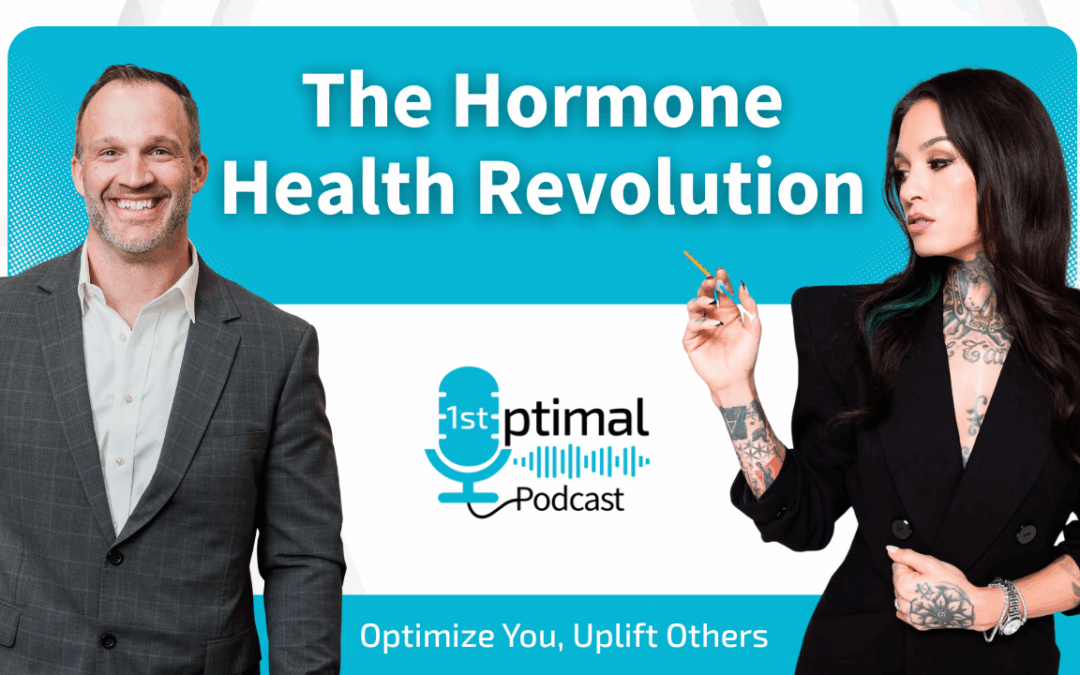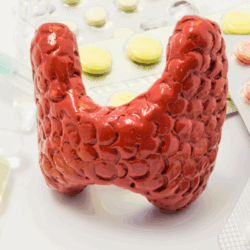For many high-performing women, unexplained digestive issues and stubborn weight gain feel like a betrayal by their own bodies. You’re used to solving problems, but this one seems immune to your efforts. The reason is that you can’t out-strategize a physiological problem without the right intelligence. The answer often lies in the complex interplay between your hormones and gut health. Issues like bloating, new food sensitivities, and abdominal fat are not isolated incidents; they are symptoms of a system-wide disruption. To truly regain control, you must address the hrt gut connection, starting with comprehensive data that reveals what’s actually happening inside.
Introduction
If you’re a woman over 35 and you’re feeling exhausted, moody, or like your body just isn’t cooperating anymore—you’re not alone. Hormone imbalances, misdiagnoses, and metabolic dysfunctions are common, but they’re often brushed off as “normal aging.” They’re not.
In a recent episode of the 1st Optimal Podcast, Joe Miller sat down with DJ, a health strategist and hormone expert who combines years of experience in fitness, medical lab consulting, and women’s health. The conversation dove deep into hormone replacement therapy (HRT), gut health, insulin resistance, lab testing, and why most women are dismissed or underserved by conventional medicine.
Here’s what every high-performing woman should know.
The State of Women’s Hormone Health
Why Standard Care Often Fails Women
In traditional medicine, most general practitioners were never trained to diagnose or treat hormonal fluctuations in non-menopausal women. That’s not a slight on the provider—it’s a system problem.
Doctors are overworked and under-resourced. They rely heavily on pharmaceutical reps for continuing education and are trained to treat diseases, not optimize function.
As DJ said:
“Women’s health sits in a weird gray area. It’s not quite gynecology, and it’s not quite endocrinology. We don’t have a place to go—so we have to find providers who went above and beyond for continuing education.”
‘Normal’ Labs Aren’t the Same as ‘Optimal’
Many women are told “your labs are normal” while they’re barely able to get out of bed. That’s because “normal” is based on population averages—not ideal functioning. Optimal ranges vary by cycle phase, lifestyle, and goals.
Common but Overlooked Symptoms of Hormonal Imbalance
You don’t have to be in menopause to experience hormonal dysfunction. Common early symptoms include:
- Fatigue (especially needing daily naps)
- Decreased libido
- Vaginal dryness or discomfort
- Mood swings
- Insomnia or poor sleep quality
- Brain fog or difficulty concentrating
Women often feel dismissed or “crazy.” But what they’re experiencing could be early perimenopause or even subclinical thyroid or sex hormone shifts.
“So many women seek psychiatric help because they think they’re going crazy, when it’s really their hormones. That’s heartbreaking.” – DJ
Digestive Issues: The Menopause Connection
If you’ve noticed that your digestion has become unpredictable lately, you’re not imagining things. The same hormonal shifts that affect your mood and energy also have a major impact on your gut. Many women are surprised to learn that issues like bloating, gas, and new food sensitivities are directly linked to perimenopause and menopause. It’s a connection that’s often missed in conventional check-ups, leaving you with uncomfortable symptoms but no clear answers. This isn’t just a minor inconvenience; it can disrupt your focus, confidence, and daily life. Understanding this gut-hormone axis is the first step toward finding real relief and getting back to feeling like yourself.
Common GI Symptoms During Menopause
Suddenly dealing with constant bloating, trapped gas, or constipation? You can thank your hormones. Estrogen and progesterone don’t just influence your reproductive system; they play a key role in regulating your entire body, including your gut. As these hormone levels fluctuate and decline, they can slow down digestion, leading to discomfort. In fact, research shows that a staggering 91% of women report changes in their gut health during this transition. It’s an incredibly common experience, yet it’s rarely discussed, leaving many women to suffer in silence, thinking it’s just something they have to live with.
How Stress and Cortisol Impact Your Gut
It’s not just your primary sex hormones causing trouble; the stress that often accompanies this life stage plays a huge role, too. Heightened stress and anxiety release cortisol, a hormone that directly affects gut function. This can worsen digestive symptoms and even lead to increased gut permeability, or “leaky gut,” where the intestinal lining becomes compromised, allowing particles to enter the bloodstream and trigger inflammation. This is why a surface-level approach rarely works. To truly address the problem, you need to see the full picture. Comprehensive testing, like a GI-MAP test to analyze your gut microbiome and cortisol testing to measure your stress response, can uncover the specific root causes of your digestive distress.
Lab Testing: What to Ask For
Most primary care providers don’t run complete hormone panels or even understand the cycle timing needed for accurate results. At 1st Optimal, comprehensive lab testing is the cornerstone of treatment.
🧪 Here’s what to request:
Sex Hormones:
- Estradiol (E2)
- Progesterone
- Total Testosterone
- Free Testosterone
- SHBG (Sex Hormone Binding Globulin)
- DHEA-S
- LH (Luteinizing Hormone)
- FSH (Follicle Stimulating Hormone)
Thyroid Markers:
- TSH
- Free T3
- Free T4
- Reverse T3 (when applicable)
Metabolic Markers:
- Fasting Insulin
- Fasting Glucose
- HbA1C
- Lipid panel
- Cortisol (serum or saliva)
- GI-MAP test (for gut health insights)
Pro Tip: Ask for your labs to be timed according to your cycle. For example, test progesterone ~7 days after ovulation—not during your follicular phase when it’s naturally low.
HRT: Customization Matters
Why Pellets Aren’t Always the Answer
Pellet therapy offers a “set it and forget it” approach—but the downside is massive hormonal fluctuations. You feel good for a short window, then crash. Adjustments aren’t possible until the next pellet, and overdosing is common.
“Why would we want massive swings in hormones when we’re trying to fix the exact symptoms caused by those fluctuations?” – DJ
Oral Testosterone? A Red Flag 🚩
Oral testosterone (especially for women) is often poorly absorbed and can result in zero improvement—at a high cost. Worse, it can increase liver strain or androgenic effects.
Custom-Compounded HRT is Best
Creams, injectables, or micronized oral progesterone (when indicated) allow for precision dosing. Compounding pharmacies can adjust for lifestyle, weight, symptoms, and lab values.
Why Topical HRT is Often a Better Choice
When it comes to hormone delivery, the method matters just as much as the dose. Topical applications, like creams or gels, are often a superior choice because they allow for steady absorption directly through the skin. This approach bypasses the liver’s first-pass metabolism, which is a huge advantage. When you take hormones orally, they go straight to the liver to be processed, which can place unnecessary strain on the organ and impact its ability to perform other vital functions. By avoiding this, topical HRT is gentler on your system and helps protect your gut health. This is a key reason why a personalized, compounded cream is often more effective and safer than a generic pill or an inflexible pellet.
How HRT Interacts With Your Gut Microbiome
The connection between your hormones and your gut is a two-way street. Your gut microbiome—the trillions of bacteria living in your digestive tract—plays a critical role in how your body processes and regulates hormones, especially estrogen. This collection of microbes is so influential that it has its own name: the estrobolome. When your estrogen levels decline during perimenopause and menopause, it can disrupt the delicate balance of your gut flora, leading to a decrease in microbial diversity. This shift can worsen symptoms like bloating, inflammation, and even mood swings. Hormone replacement therapy works to restore estrogen levels, which in turn can help rebalance the gut environment and alleviate these interconnected issues.
Restoring Gut Balance and Diversity
One of the most significant benefits of properly administered HRT is its ability to restore harmony to your gut. Research shows that reintroducing estrogen can correct imbalances caused by hormonal decline. For example, studies have found that HRT can bring levels of certain bacteria, like Eggerthella, back to a healthy baseline. This is why a comprehensive approach is so important. At 1st Optimal, we use advanced testing like the GI-MAP to get a clear picture of your unique gut microbiome. This allows us to see exactly what’s happening inside and tailor a protocol that supports both your hormonal and digestive health, ensuring that every part of your system is working together optimally.
Beyond the Gut: Improving Vaginal Health
The benefits of HRT extend to the vaginal microbiome as well. Just like your gut, the vaginal environment relies on a healthy balance of bacteria to maintain its acidic pH and protect against infections. Estrogen is essential for feeding the good bacteria, particularly Lactobacillus. When estrogen levels drop, so does the population of these protective microbes, leading to common symptoms like vaginal dryness, discomfort, and an increased risk of UTIs. By replenishing estrogen, HRT helps re-establish a healthy vaginal microbiome, increasing lubrication and restoring tissue health from the inside out. This is a crucial piece of the puzzle for overall comfort and quality of life.
Potential Side Effects and Considerations
While HRT can be transformative, it’s not without potential side effects, and it requires careful management. Although it often improves gut motility, some women may experience digestive issues like bloating or nausea as their bodies adjust. In rare cases, it can be associated with conditions like gastroparesis, or slowed stomach emptying. This underscores why a one-size-fits-all approach is never the answer. Working with a provider who monitors your progress, listens to your feedback, and adjusts your protocol based on ongoing lab results is non-negotiable. This personalized oversight ensures you get all the benefits of hormone therapy while minimizing any potential risks, keeping you on track toward your health goals.
Gut Health, Inflammation & Hormones
Your Gut Is Your Second Brain—and Hormonal Hub
DJ recently completed a GI-MAP, revealing bacterial imbalances, low diversity, and inflammation, likely driven by chronic stress—not diet.
“Even with dialed-in nutrition, my gut flora was off. It was eye-opening. Stress was the culprit.”
Gut dysbiosis can:
- Worsen hormone detoxification
- Increase systemic inflammation
- Lead to nutrient deficiencies
- Raise cortisol and disrupt insulin sensitivity
The Estrobolome: Your Body’s Estrogen Manager
Deep within your gut is a specialized community of bacteria with a critical job: managing your estrogen. This collection of microbes is called the “estrobolome,” and it’s responsible for processing and modulating the body’s estrogen levels. When this delicate ecosystem is balanced, your hormones are more likely to be, too. But when factors like stress, poor diet, or the natural hormonal shifts of perimenopause and menopause disrupt these bacteria, it can throw your entire system off. An unhealthy estrobolome can lead to either too much or too little active estrogen circulating in your body, contributing to symptoms like mood swings, weight gain, and low energy.
How Gut Bacteria Influence Hormone Levels
So, how exactly do gut microbes interact with your hormones? Certain bacteria in your gut produce an essential enzyme that helps metabolize estrogen. This enzyme effectively “activates” estrogen that has been processed by the liver, converting it back into a free, usable form that your body’s tissues can absorb. If your gut health is compromised, this process breaks down. Without the right bacteria to do the job, your body can’t maintain proper estrogen balance. This is a perfect example of why you can’t address hormonal issues without first looking at the gut—the two systems are completely intertwined.
Estrogen’s Protective Role in GI Health
Estrogen does more than just regulate your cycle; it also plays a significant protective role in your gastrointestinal health. Research shows that estrogen helps maintain the integrity of your gut lining and can protect against conditions like inflammatory bowel disease (IBD). It interacts with specific receptors in the colon that are crucial for keeping the gut barrier strong and preventing chronic inflammation. Think of estrogen as a key defender of your gut. When its levels are optimal, it helps create a resilient environment. But when those levels decline, that protective shield weakens, leaving you more vulnerable to digestive distress and inflammation.
How Low Estrogen Increases Risk for GI Disease
When estrogen levels drop, as they do during menopause or in conditions like Premature Ovarian Insufficiency (POI), the consequences extend directly to your gut. One of the most significant impacts is a decrease in microbial diversity. A less diverse gut microbiome is less resilient and more susceptible to imbalance, which can pave the way for a host of gut-related problems. This drop in diversity is a key reason why many women start experiencing new or worsening digestive issues as they get older. It’s not just a coincidence; it’s a direct physiological response to hormonal changes that begin in the gut.
The Link to IBS and GERD
If you’ve noticed that symptoms of Irritable Bowel Syndrome (IBS) or acid reflux (GERD) have appeared or worsened with age, your hormones are likely a contributing factor. IBS is far more common in women, and estrogen appears to play a role by influencing gut sensitivity and motility. Similarly, GERD rates in women tend to increase significantly after age 50, coinciding with the menopausal drop in estrogen. These conditions are often treated as isolated digestive problems, but for many women, they are a clear signal of an underlying hormonal imbalance that needs to be addressed at the root.
When to See a Doctor for Gut Issues
If you’re struggling with persistent bloating, gas, constipation, or other stomach issues, especially during perimenopause or menopause, it’s time to talk to a provider who understands this connection. You should definitely seek medical advice if you experience significant changes in your bowel habits or severe, painful bloating. Instead of just treating the symptoms, it’s crucial to find a practitioner who will investigate the root cause. At 1st Optimal, we start with comprehensive testing, like the GI-MAP, to get a clear picture of your gut microbiome. This data-driven approach allows us to see exactly what’s happening inside and create a personalized plan that addresses both your gut health and your hormonal balance together.
Supportive Compounds:
- KPV – Anti-inflammatory peptides for gut lining repair
- L-Glutamine – Supports gut mucosa
- Digestive enzymes & bitters – Improve breakdown and absorption
GLP-1s & the Metabolic-Hormone Connection
GLP-1 receptor agonists like semaglutide (Ozempic, Wegovy) are now mainstream, but their impact goes far beyond weight loss.
PCOS, Insulin, and Hormones
GLP-1s can reduce insulin resistance, regulate appetite, and indirectly improve sex hormone balance in women with PCOS or metabolic syndrome. One study published in Obesity Reviews (2022) showed a significant improvement in ovulatory function in PCOS patients using GLP-1s.
DJ shared how even lower-income clients, who can’t afford weekly supplements or coaching, can benefit from cost-conscious GLP-1 protocols that include:
- Low doses
- Twice-weekly dosing to reduce side effects
- GDA (glucose disposal agents) like berberine on off-days
Understanding “Meno Belly” and Metabolic Changes
One of the most frustrating experiences for women during perimenopause and menopause is the sudden appearance of stubborn abdominal fat, often called “meno belly.” This isn’t a result of letting yourself go; it’s a direct consequence of significant hormonal and metabolic shifts happening inside your body. Understanding the “why” is the first step toward creating an effective strategy to address it. It’s not just about aesthetics—it’s about reclaiming your long-term health from the inside out.
Why Weight Gain Happens During Menopause
As your estrogen levels decline during menopause, your body’s fat storage patterns change. Fat that was once stored primarily on your hips and thighs begins to redistribute to your abdomen. This hormonal shift also makes your body less sensitive to insulin, the hormone responsible for managing blood sugar. When your cells become insulin resistant, your body struggles to use glucose for energy, leading it to store more of it as fat—specifically, visceral fat. This is why you might find yourself gaining weight even if your diet and exercise habits haven’t changed.
The term “meno belly” refers to this increase in visceral fat, which is different from the subcutaneous fat you can pinch. Visceral fat builds up deep within your abdominal cavity, surrounding your vital organs. This type of fat is metabolically active and can release inflammatory substances that contribute to serious health problems. It’s directly linked to a higher risk of inflammation, insulin resistance, high blood pressure, and heart disease, making it a critical health marker to manage.
A Combined Approach to Weight Management
Because menopausal weight gain is driven by complex hormonal and metabolic factors, simply eating less and exercising more often isn’t enough. A successful strategy requires a multi-layered approach that addresses the root causes. This means looking beyond the scale and focusing on restoring hormonal balance, improving insulin sensitivity, and supporting your body with the right nutrition. Combining targeted medical therapies with foundational lifestyle changes offers the most effective path forward for lasting results.
Pairing HRT with GLP-1s for Better Results
Hormone Replacement Therapy (HRT) can be a game-changer. By replenishing estrogen, HRT helps reduce the tendency to store visceral fat and can improve your body’s response to insulin. However, for many women, especially those with significant insulin resistance, pairing HRT with other therapies creates an even more powerful effect. This is where GLP-1 receptor agonists like semaglutide come in. These medications work by helping to regulate appetite and blood sugar, directly tackling the metabolic dysfunction that drives weight gain.
This combination addresses the problem from two critical angles: HRT restores the hormonal environment, while GLP-1s fix the metabolic signaling. This is the essence of a sophisticated, data-driven health strategy. At 1st Optimal, our medically guided weight loss programs are built on comprehensive lab testing to see what’s happening under the surface. This allows us to create a fully personalized plan that may include HRT, GLP-1s, or other protocols tailored to your unique biology, ensuring you get the most effective treatment possible.
The Importance of Protein Intake
Medical interventions are powerful, but they work best when supported by strong nutritional foundations. For women managing metabolic changes, prioritizing protein is non-negotiable. Protein is essential for maintaining lean muscle mass, which is metabolically active and helps support a healthy metabolism. It is also the most satiating macronutrient, meaning it helps you feel full and satisfied after meals, which is key for managing cravings and reducing overall calorie intake without feeling deprived or hungry.
A good rule of thumb is to aim for 20-30 grams of high-quality protein with every meal. For a 150-pound woman, this could mean a daily intake of 70 to 140 grams, depending on her activity levels and specific goals. This isn’t about following a restrictive diet; it’s about strategically fueling your body to support muscle health and metabolic function. When you combine a protein-forward eating style with a targeted medical approach, you create a comprehensive system for taking back control of your body composition and health.
Trending Now: What’s Changing in Women’s Health
🚨 The Rise of Weight Loss Medications = More Female Health Conversations
The mainstreaming of GLP-1s has opened the door for more women to ask questions about their health. And it’s not just about weight loss anymore—it’s about energy, libido, sleep, and feeling vibrant again.
Shift from Performance to Longevity
DJ noted a positive cultural shift:
- From extreme biohacking to sustainable, evidence-based optimization
- From gym aesthetics to real-world performance and aging gracefully
FAQ: What Women 35+ Are Asking
What’s the best time in my cycle to test hormones?
Ideally, 7 days after ovulation to test progesterone and compare it to estradiol. For FSH and LH, early follicular phase (days 2–5) is best.
Can I start HRT before menopause?
Yes. Symptoms of hormonal decline begin years before menopause (aka perimenopause). Early intervention can prevent long-term issues.
How do I know if my labs are “optimal”?
“Optimal” means you function well and feel well—not just that you’re inside a wide reference range. Work with a provider who understands functional ranges.
What are signs I need gut testing?
- Bloating or irregular bowel movements
- Fatigue after eating
- Skin flare-ups
- Autoimmune issues
- Recurring infections or food sensitivities
Is HRT safe long-term?
When monitored correctly, bioidentical HRT has been shown to improve bone density, reduce cardiovascular risk, and enhance quality of life. It’s not a blanket prescription—it’s personalized medicine.
What are GLP-1s and should I consider one?
GLP-1s are medications that mimic gut hormones to regulate appetite and insulin. They’re especially helpful for insulin resistance, PCOS, and stubborn weight gain. Work with a functional provider to assess candidacy.
Conclusion
Hormonal health is too complex, too personal, and too important to trust in outdated systems. Whether you’re a high-level executive, athlete, mom—or all three—your well-being affects everything you do.
🔍 Don’t settle for feeling “fine.”
If you’re feeling off, tired, or dismissed, you’re not crazy. You might just be hormonally misaligned.
📞 Book a complimentary call with a specialist at 1st Optimal.
🧬 Or order a personalized lab panel and get the data you need to take action.
Your health isn’t just about survival. It’s about thriving.
Key Takeaways
- Treat Digestive Issues as a Hormonal Signal: Unexplained bloating, gas, and new food sensitivities are often tied to your estrobolome—the gut bacteria that manage estrogen. To find the root cause, start with comprehensive gut and hormone testing instead of just treating the symptoms.
- Advocate for Optimal, Not ‘Normal,’ Lab Results: Standard lab ranges often fail to identify the source of your symptoms. True optimization requires a provider who uses comprehensive data to create a personalized plan with adjustable therapies, like topical HRT, instead of inflexible, one-size-fits-all protocols.
- Use a Combined Strategy to Address Metabolic Changes: Stubborn abdominal fat is a metabolic issue driven by hormonal shifts, not a lack of effort. The most effective solution pairs foundational habits like a high-protein diet with targeted medical support like HRT and GLP-1s to address the root cause.







